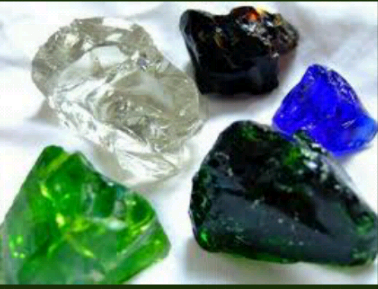There are some things readers really need to know if we wanted to know more about Stone Honor / Gems. Not infrequently this knowledge only for consumption businessman, collector, or the researchers minerals. Posts are collected from multiple sources may be able to treat more curiosity about the characteristics of the stone or the Noble Gems
Crystal
Crystal

Often we hear dikeseharian. But in the case of stones, crystal is a homogeneous object, shaped very geometric and the atoms are arranged in a crystal lattice, due to the crystal lattice structure is different so it's also different. Crystals can form in nature (mineral) or in the laboratory. Crystal means having the form of a rather symmetric (symetris) and are limited on many sides by plane, thus giving bangin a distinctive character to the mineral in question. Solids composed of atoms that are said to have organized kristalen structure. Crystal form is divided into six forms, namely:
- REGULAR, isometric cube or three axle same length and intersect perpendicular to each other (eg, Diamond Stone, rock salt)
- Tetragonal (four-star) chalkopirit example, rutile, zircon.
- Hexagonal (six-star) apalit example, beryl, corundum.
- ORTOROMBIS (sliced diamonds) Berit example, sulfur, topaz.
- Monoclinic (lopsided) example gypsum, muscovite, augite.
- TRIKLIN (oblique, third direction) albit example, anortit, Distin.
Mineral
Mineral definition of a material nature, a lot of reviews and theories from experts. But in a nutshell is a substance contained in the natural and there is a distinctive chemical composition and crystal structure usually have clear, which sometimes can manifest in a particular geometric shape. The term mineral can have a variety of meanings, depending on the viewing angle and what products. Noble or Gems Stone is a mixture of mineral elements, thus showing a captivating shape or form in terms of beauty. Each mineral has a character composed of a crystalline structure. And the longer the mineral lasts a long time in the world, the more beautiful crystals formed.
Hardness Scale (using the Mohs scale):
Is a physical properties of the rocks, which are influenced by the internal layout of the atom. To measure mineral hardness Mohs Hardness Scale is used, the following are illustrative examples of the scale of violence:
Mohs scale 1: Talk, easily scratched with a thumbnail
Mohs Scale 2: GIPS, easily scratched with a thumbnail
Mohs Scale 3: Calcite, easily scratched with a knife
Mohs Scale 4: fluorite, easily scratched with a knife
Mohs scale 5: Apatite, can be cut with a knife (it's hard)
Mohs Scale 6: Ortoklas, can dicuwil thin section with a knife edge
Mohs Scale 7: Quartz, Emerald, Hematite can scratch the glass
Mohs Scale 8: Topaz, can scratch the glass
Mohs Scale 9: Ruby, sapphire, corundum, topaz can scratching (ruby gemstones, sapphire blue hue / sapphire)
Mohs Scale 10: Diamond, can scratch corundum crystals diamond shape is solid besisi eight (octahedron)

In terms of hardness, diamond has the highest hardness, so it is widely used as a drill bit in the oil, so it can penetrate through the padas, and oil drilling in the rock layers.
Researchers mineral known, Mr.K.E. Kinge (1860) convey grouping Batu Mulia / Gems who made jewelry in five classes as follows:
- Gemstone Class I (Diamond, Ruby, Sapphire, Topaz, Cubic Zirconia Chrysoberyl) Rated at home between 8 s / d 10 Mohs Scale
- Gems class II (Beryl, Zircon, Emerald, Aquamarine, Amethyst, Garnet, Spinel, Quartz) Loud value between 7 s / d 8 Mohs Scale
- Gemstone Class III (Lapiz Lazuli, Citrin, Tourqis) is classified as a class Gemstones kinds of precious stones and precious stones hearted, hard value approximately 7 Mohs Scale, consisting mostly of grit acid (kiezelzuur).
- Responsibility-Precious stones are stones grade IV (Phenakite moonstone Opal Peridot Quartz Beryl), hardness values between 4-7 Mohs Scale 5.
- Class V and class V value rigors specific gravity levels vary greatly. The color is dark (dull) and mostly rather murky, opaque, slightly shiny stone, and Harganyapun very cheap when compared to the price of precious stones. In this class, including marble and stone are not classified as class V precious stones. An example is the agate.
Color
What's wrong with the so-called Color? Colors can be seen when there is some wavelengths removal process, some absorb specific wavelengths of the visible spectrum. Spectrum can be seen consist of red, orange, yellow, green, blue, indigo and violet. When there is a transfer of energy wavelength will affect and will change color and if the gems it contains iron will usually look dark colored, while those containing aluminum usually looks bright, but there is still colored minerals such as water (berkristal) and named Idhiochromatic.
Here the color is due to the innate nature there is something of substances in jewels as a source of color (pigment agent) which are minerals which are: sulfur yellow; malakit green color; azurite blue color; pyrite yellow; magatit color is black; augite green color; gutit yellow to brown; hematite red color etc.. There is also a mineral that has an assortment of colors and termed allokhromatik, this is due to the presence of dye (pigment), terkurungnya some object (inclusion) or the presence of a mixture of substances (Impurities). Impurities are elements which is comprised of Ti, V, Cr, Mn, Fe, Co, Ni, Cu, and usually not present in a mixture of pure elements are concentrated in low gemstone. Assorted colors are very beautiful gemstone and mempersona man so that man gave the title of "noble" in these stones.
this article is a nice gemstone info!
ReplyDelete